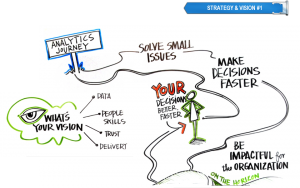Analytics Infrastructure: Vision & Strategy Consideration #1 (Part 1 of 15 considerations for Analytics Infrastructure)
In a perfect world, the entire organization would be aligned, and the analytics vision would be driven by top down, executive leadership. Since we aren’t living in a perfect world, it often takes work to drive alignment and convince people that the investment of time, effort and money will pay dividends. The good thing is that there is a perfect storm relating to analytics – you could argue that big data hype is overblown, but the positive aspect of big data is that it is driving interest in analytics. Whether it’s the oft-sighted McKinsey report, the Hollywood hit Moneyball, or federal funding of big data projects, or the desire to cash in on social media, the impact at the business level is undeniable. It’s not just technical Websites or publications, but business journals and Web properties are also focused on the impact of business analytics and big data. That hype is providing executive level impetus that in some cases is leading to top-down motivation and alignment. If that is not happening in your organization, that doesn’t mean that you are doomed to failure. There are many organizations that are driving success from the bottom up or success that is initiated at the project level. This can include a single project success that leads to executive level exposure – executives see the results and realize that analytics can be replicated across multiple business disciplines.

So what can IT do to help drive alignment?
There is a lot written about IT and business alignment. Organizations are all over the board on this topic – I talk to some organizations that seem offended by the very description “IT vs. Business”, they feel that they have long since moved past this topic. Yet other organizations relate harrowing stories about dysfunctional episodes relating to IT and business. IT and business alignment is an important aspect to analytic alignment, especially enterprise level initiatives since IT needs to play a critical role when analytics is used pervasively, otherwise silo based projects will result in substandard results. So what is IT to do? Here are a few thoughts relative to analytic alignment and establishing common goals:
Drive executive involvement:
- Look for industry related success that clearly demonstrates the value of analytics and the competitive exposure that will result from inactivity.
- Work towards enterprise impact by driving project-level success. As with many initiatives a big bang approach is not necessary. Identify high impact projects that will lead to significant business impact. Build momentum based by stringing together multiple successful projects.
Align with major corporate initiatives:
- Determine how analytics can be used to support major corporate initiatives – revenue generation, new channel development, customer relationship initiatives are good starting points.
- Demand revenue or P&L related responsibility – break out of the cost center mentality by looking for revenue or P&L opportunities to be driven by IT. Just as many IT organizations stepped into a revenue position with the advent of E-commerce, look for opportunities to monetize social media, drive innovation through analytics or optimize decision making that will lead to competitive advantage.
Foster understanding between various constituents:
- This seems simple, but I can’t count the number of organizations that I have worked with where there is disenchantment between IT and the business or between various business disciplines. Foster a common understanding of various job roles by clearly identifying different job responsibilities relate to major corporate initiatives.
- Consider x-training, job sharing, co-locating resources, mutual bonus incentives, etc. that will drive understanding and foster teamwork. One leading organization told me that if someone visited her company, they wouldn’t be able to tell whether a team member was on the IT or marketing staff. This level of collaboration has driven major results in terms of improved marketing efficiencies.
Implement IT and information governance
- IT portfolio management is often used to drive alignment… but this should be part of a larger IT governance approach that facilitates leadership and ensures optimal organizational structures and processes.
- Leverage strong data / information governance principles to ensure that data is properly managed, which is the bedrock for trusted analytic results.
Focus on key business processes and decisions
- Look to optimize business processes by leveraging analytics – including embedding analytic results directly into operational / transactional systems.
- Identify key decisions and leverage all data at your disposal to optimize and speed decisions so that you outperform your competition.
Identify measureable goals and accountability
- Some would argue that if you can’t measure it, it’s not worth doing. Although this may be an overstatement, measureable goals can help drive alignment and help eliminate organizational dissonance.
- Accountability should not be limited to IT service level agreements (SLAs). Accountability should be based on clearly defined measurements and should be based on reciprocity.
Although it’s unlikely that you can implement all of these suggestions, the important thing is the organizational mindset – if you achieve the right mindset, it will be much easier to determine what tactics should be used to drive alignment and establish common goals.
Next up… Support multiple forms of analytics for maximum value

1 Comment
Pingback: 15 Considerations for Analytics Infrastructure - Information Architect